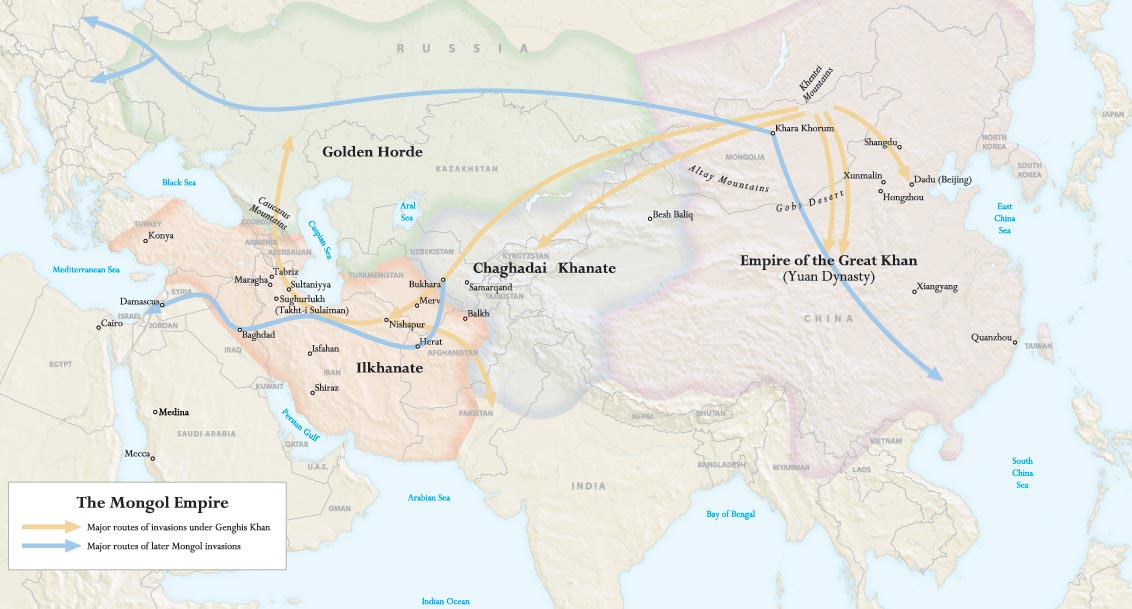|
Yuan China
The Yuan dynasty (), officially the Great Yuan (; xng, , , literally "Great Yuan State"), was a Mongol-led imperial dynasty of China and a successor state to the Mongol Empire after its division. It was established by Kublai, the fifth khagan-emperor of the Mongol Empire from the Borjigin clan, and lasted from 1271 to 1368. In orthodox Chinese historiography, the Yuan dynasty followed the Song dynasty and preceded the Ming dynasty. Although Genghis Khan had been enthroned with the Han-style title of Emperor in 1206 and the Mongol Empire had ruled territories including modern-day northern China for decades, it was not until 1271 that Kublai Khan officially proclaimed the dynasty in the traditional Han style, and the conquest was not complete until 1279 when the Southern Song dynasty was defeated in the Battle of Yamen. His realm was, by this point, isolated from the other Mongol-led khanates and controlled most of modern-day China and its surrounding areas, includ ... [...More Info...] [...Related Items...] OR: [Wikipedia] [Google] [Baidu] |
Post-classical History
In world history, post-classical history refers to the period from about 500 AD to 1500, roughly corresponding to the European Middle Ages. The period is characterized by the expansion of civilizations geographically and development of trade networks between civilizations. This period is also called the medieval era, post-antiquity era, post-ancient era, pre-modernity era or pre-modern era. In Asia, the spread of Islam created a series of caliphates and inaugurated the Islamic Golden Age, leading to advances in science in the medieval Islamic world and trade among the Asian, African and European continents. East Asia experienced the full establishment of power of Imperial China, which established several prosperous dynasties influencing Korea, Vietnam, and Japan. Religions such as Buddhism and Neo-Confucianism spread in the region. Gunpowder was developed in China during the post-classical era. The Mongol Empire connected Europe and Asia, creating safe trade and stabilit ... [...More Info...] [...Related Items...] OR: [Wikipedia] [Google] [Baidu] |
Beijing
} Beijing ( ; ; ), alternatively romanized as Peking ( ), is the capital of the People's Republic of China. It is the center of power and development of the country. Beijing is the world's most populous national capital city, with over 21 million residents. It has an administrative area of , the third in the country after Guangzhou and Shanghai. It is located in Northern China, and is governed as a municipality under the direct administration of the State Council with 16 urban, suburban, and rural districts.Figures based on 2006 statistics published in 2007 National Statistical Yearbook of China and available online at archive. Retrieved 21 April 2009. Beijing is mostly surrounded by Hebei Province with the exception of neighboring Tianjin to the southeast; together, the three divisions form the Jingjinji megalopolis and the national capital region of China. Beijing is a global city and one of the world's leading centres for culture, diplomacy, politics, financ ... [...More Info...] [...Related Items...] OR: [Wikipedia] [Google] [Baidu] |
Church Of The East In China
The Church of the East (also known as the Nestorian Church) historically had a presence in China during two periods: first from the 7th through the 10th century in the Tang dynasty, when it was known as ''Jingjiao'' ( zh, t=景教, w=Ching3-chiao4, p=Jǐngjiào, l=Luminous Religion), and later during the Yuan dynasty in the 13th and 14th centuries, when it was described alongside other foreign religions like Catholicism and possibly Manichaeism as ''Yelikewen jiao'' ( zh, t=也里可溫教, p=Yělǐkěwēn jiào). After centuries of hiatus, the first Assyrian Church of the East Divine Liturgy was celebrated in China in 2010. Tang dynasty History Two possibly Church of the East monks were preaching Christianity in India in the 6th century before they smuggled silkworm eggs from China to the Eastern Roman Empire. The first recorded Christian mission to China was led by the Syriac monk known in Chinese as Alopen. Alopen's mission arrived in the Chinese capital Chang'an i ... [...More Info...] [...Related Items...] OR: [Wikipedia] [Google] [Baidu] |
Chinese Folk Religion
Chinese folk religion, also known as Chinese popular religion comprehends a range of traditional religious practices of Han Chinese, including the Chinese diaspora. Vivienne Wee described it as "an empty bowl, which can variously be filled with the contents of institutionalised religions such as Buddhism, Taoism, Confucianism, the Chinese syncretic religions". This includes the veneration of ''shen'' (spirits) and ancestors, exorcism of demonic forces, and a belief in the rational order of nature, balance in the universe and reality that can be influenced by human beings and their rulers, as well as spirits and gods. Worship is devoted to gods and immortals, who can be deities of places or natural phenomena, of human behaviour, or founders of family lineages. Stories of these gods are collected into the body of Chinese mythology. By the Song dynasty (960-1279), these practices had been blended with Buddhist doctrines and Taoist teachings to form the popular relig ... [...More Info...] [...Related Items...] OR: [Wikipedia] [Google] [Baidu] |
Tengrism
Tengrism (also known as Tengriism, Tengerism, or Tengrianism) is an ethnic and old state Turko- Mongolic religion originating in the Eurasian steppes, based on folk shamanism, animism and generally centered around the titular sky god Tengri. Tengri was not considered a deity in the usual sense, but a personification of the universe. The purpose of life is, according to the Tengris view, to live in harmony with the universe. It was the prevailing religion of the Turks, Mongols, Bulgars, Xiongnu, Huns and possibly the Hungarians, and the state religion of several medieval states: First Turkic Khaganate, Western Turkic Khaganate, Eastern Turkic Khaganate, Old Great Bulgaria, First Bulgarian Empire, Volga Bulgaria, and Eastern Tourkia (Khazaria), Mongol Empire. In '' Irk Bitig'', a ninth century manuscript on divination, Tengri is mentioned as (God of Turks). According to many academics, Tengrism was a predominantly polytheistic religion based on shamanistic concept of ... [...More Info...] [...Related Items...] OR: [Wikipedia] [Google] [Baidu] |




.jpg)
